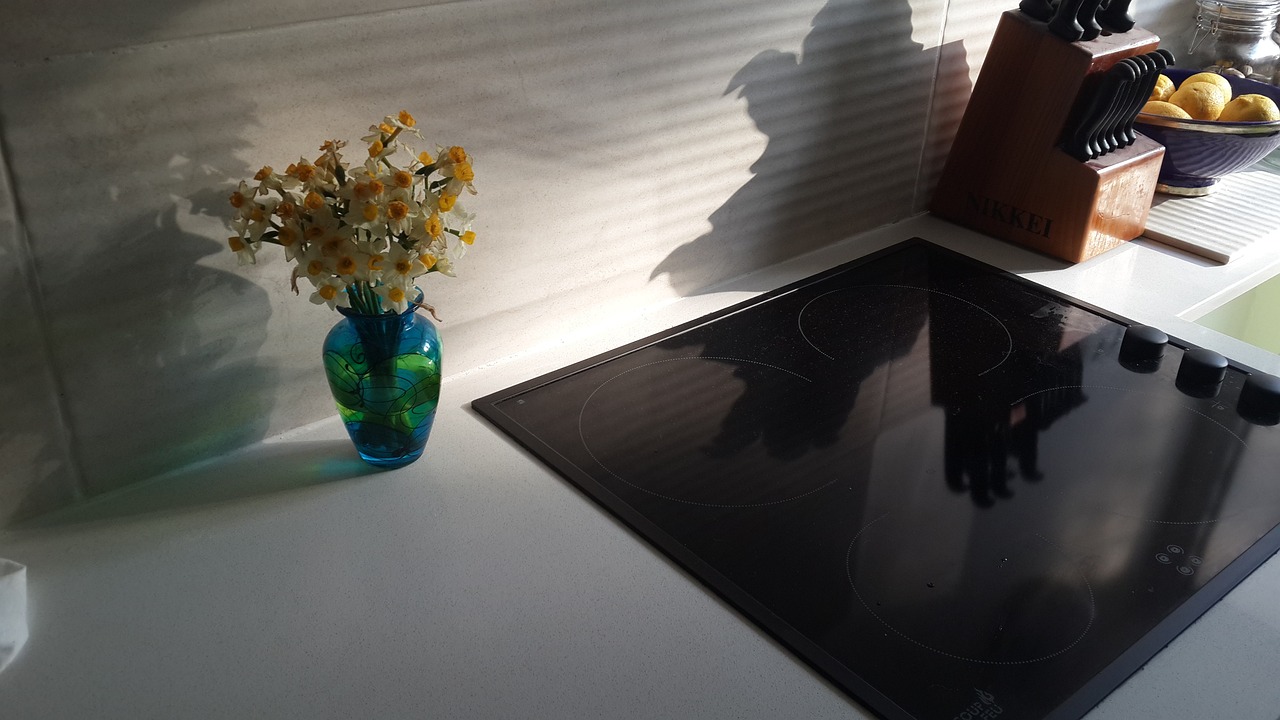Top Tips for Keeping Your Cooktop in Prime Condition

Maintaining your cooktop is crucial for its longevity and optimal performance. Regular care not only keeps it looking pristine but also ensures it functions efficiently. A well-maintained cooktop can last between 8 to 18 years, depending on the model and care level. By cleaning spills immediately and using suitable cookware, you can extend the lifespan of your appliance. Investing in protective measures like stove top protectors further enhances durability. Remember, a little effort in maintenance today saves you from costly repairs tomorrow.
Key Takeaways
Establish a daily cleaning routine by wiping down your cooktop after each use to prevent stains and maintain its appearance.
Use natural cleaning solutions like baking soda and vinegar for tough stains, ensuring a safe and effective cleaning process.
Invest in stove top protectors to shield your cooktop from spills and scratches, extending its lifespan and simplifying cleaning.
Conduct regular maintenance checks to catch small issues early, preventing them from escalating into costly repairs.
Avoid using abrasive cleaners or tools, as they can damage the surface of your cooktop; opt for gentle cleaning methods instead.
Apply a protective coating after deep cleaning to enhance shine and create a barrier against future stains and spills.
Remember, a little effort in maintenance today can save you from expensive repairs tomorrow, ensuring your cooktop remains a reliable kitchen companion.
Daily Maintenance Routine
Establishing a daily maintenance routine for your cooktop ensures it remains in top condition. This routine involves simple steps that make a significant difference in the longevity and performance of your appliance.
Quick Cleaning After Use
A quick clean after each use is essential for maintaining your cooktop's appearance and functionality. Begin by wiping down the cooktop with a damp cloth. This step removes any immediate spills or splatters, preventing them from hardening and becoming difficult to clean later. Using microfiber towels is recommended as they effectively capture debris without scratching the surface.
For a more thorough clean, apply mild detergents. These are gentle yet effective in removing grease and food residues. White vinegar and baking soda offer a cost-effective solution for cleaning your cooktop after each use. They are natural and safe for most surfaces, ensuring an easy cleanup without harsh chemicals.
Preventing Common Issues
Preventing issues before they arise is a crucial part of your daily maintenance routine. Avoid spills and splatters by using cookware with high sides and lids. This simple practice minimizes mess and reduces the risk of stains and damage.
Regularly check for gas leaks or electrical issues. This proactive approach ensures your cooktop operates safely and efficiently. If you notice any unusual smells or sounds, address them immediately to prevent further complications.
Investing in stove top protectors is another effective strategy. These protectors act as a barrier, catching food debris before it reaches the burners. They make cleaning the cooktop easier and help maintain its pristine condition. Additionally, a thin layer of cooktop protectant can be applied after deep cleaning to add extra protection and make future cleaning tasks simpler.
By incorporating these practices into your daily routine, you ensure your cooktop remains in excellent condition, ready for your next culinary adventure.
Deep Cleaning Techniques for Electric Stove Cleaning
Maintaining your cooktop's pristine condition requires more than just daily upkeep. A thorough deep cleaning process is essential for electric stove cleaning, ensuring your appliance remains efficient and visually appealing.
Removing Tough Stains
Tough stains can mar the surface of your cooktop, but you can tackle them effectively with natural cleaning solutions. Baking soda and vinegar are powerful allies in this battle. To start, mix equal parts of white vinegar and water in a spray bottle. Spray this solution over the cooled stovetop. Then, sprinkle baking soda generously over the sprayed area. This combination will create a fizzing reaction that helps in breaking down stubborn stains and grease.
Cover the mixture with a hot, damp cloth and let it sit for 15-20 minutes. This step allows the natural cleaning solutions to penetrate and loosen the grime. Afterward, wipe the surface clean with a microfiber cloth. This method not only aids in removing burnt-on food but also leaves your cooktop with a streak-free shine.
For particularly stubborn stains, consider employing specialized cooktop cleaners. These products are designed to tackle tough residues without damaging the surface. Always follow the manufacturer's instructions to ensure safe and effective use.
Restoring Shine
Once you've tackled the stains, restoring the shine of your cooktop is the next step. Polishing with microfiber cloths is an excellent way to achieve this. Microfiber cloths are gentle on surfaces and effectively remove any remaining residue, leaving your cooktop gleaming.
To further enhance the shine and protect the surface, apply a protective coating. This coating acts as a barrier against future spills and stains, making future cleaning tasks easier. It also helps in preventing stubborn stains from setting in, ensuring your cooktop remains in top condition.
By incorporating these deep cleaning techniques into your routine, you ensure that your electric stove cleaning efforts are both effective and efficient. Regular deep cleaning not only maintains the appearance of your cooktop but also extends its lifespan, allowing you to enjoy a spotless cooking surface for years to come.
Protective Measures for Caring for Your Glass Cooktop

Caring for your glass cooktop involves more than just regular cleaning. Implementing protective measures ensures its longevity and maintains its pristine appearance. Here are some effective strategies to keep your cooktop in top condition.
Using Stove Top Protectors
Stove top protectors are essential tools in maintaining the integrity of your glass cooktop. They offer a layer of protection against spills, splatters, and scratches.
Benefits of Silicone Mats
Silicone mats provide excellent protection for your cooktop. These mats are heat-resistant and waterproof, making them ideal for preventing scratches and stains. By using silicone mats, you can extend the life of your cooktop by keeping it clean and free from damage. They are flexible and durable, ensuring they fit snugly over your cooktop surface.
How to Properly Fit and Clean Protectors
Proper fitting of stove top protectors is crucial for effective protection. Ensure that the protectors are custom-designed to fit your specific cooktop model. This precision fit prevents food debris from reaching the surface underneath. Cleaning these protectors is simple. Remove them after cooking and wash them with mild soap and water. Regular cleaning keeps them in good condition and ensures your cooktop remains protected.
Other Preventive Strategies
In addition to using stove top protectors, other preventive measures can further safeguard your glass cooktop.
Installing Splash Guards
Splash guards are another effective tool in caring for your glass cooktop. They prevent liquids from spilling over the edges and causing stains or damage. Install splash guards around the perimeter of your cooktop to catch any splatters during cooking. This simple addition can significantly reduce cleaning time and effort.
Regular Maintenance Checks
Conducting regular maintenance checks is vital for the long-term care of your cooktop. Inspect the surface for any signs of wear or damage. Addressing small issues promptly prevents them from escalating into costly repairs. Regular checks ensure your cooktop remains in optimal working condition.
By incorporating these protective measures into your routine, you enhance the durability and appearance of your glass cooktop. These strategies not only simplify cleaning but also extend the lifespan of your appliance, allowing you to enjoy a spotless cooking experience.
Common Mistakes to Avoid in Cooktop Maintenance
Maintaining your cooktop properly involves avoiding certain common mistakes. These errors can lead to damage and reduce the lifespan of your appliance. By being aware of these pitfalls, you can ensure your cooktop remains in excellent condition.
Actions That Can Damage the Cooktop
Using Abrasive Cleaners or Tools
One of the most common mistakes is using abrasive cleaners or tools on your cooktop. These harsh substances and implements can scratch and damage the surface. Instead, opt for gentle cleaning solutions and soft cloths. For instance, microfiber cloths are ideal as they clean effectively without causing harm.
"All too many times we receive calls about glass cooktops being cracked or bubbling. Much of these instances could have been prevented." — Guinco
This quote highlights the importance of using the right cleaning methods. Avoiding abrasive materials can prevent costly repairs and maintain the cooktop's appearance.
Ignoring Small Issues That Can Escalate
Another mistake is ignoring small issues that can escalate over time. Minor problems, such as tiny scratches or slight discolorations, might seem insignificant. However, they can develop into larger issues if left unaddressed. Regularly inspect your cooktop for any signs of wear or damage. Addressing these early can prevent more serious problems down the line.
Conduct routine checks to ensure everything is functioning correctly. If you notice anything unusual, take action immediately. This proactive approach helps maintain the efficiency and safety of your cooktop.
By avoiding these common mistakes, you can protect your cooktop and extend its lifespan. Proper care and attention to detail will ensure your appliance remains a reliable part of your kitchen for years to come.
Consistent maintenance is the key to a spotless cooktop and its longevity. By incorporating a simple routine, you can extend the lifespan of your appliance and reduce heat damage. Clean spills once the surface cools, and remember, do not use your cooktop as a cutting board. Avoid harsh chemicals; instead, rely on gentle techniques and tricks for effective cleaning. A well-maintained cooktop not only enhances your cooking experience but also protects your investment. Embrace these practices to enjoy a pristine and efficient cooktop for years to come.
FAQ
How do I clean the ceramic top on my electric freestanding range?
To clean your ceramic cooktop, apply a few drops of glass ceramic cleaning cream to the cool, soiled area. Use a damp paper towel to rub the cream gently. Wipe until all soil and cream are removed. Frequent cleaning leaves a protective coating, which is essential in preventing scratches and abrasions.
What’s the best way to clean a non-glass electric stovetop?
Create a paste using baking soda and water. Apply it to the cooled stovetop and gently scrub with a soft sponge. Rinse with a solution of equal parts water and white vinegar. For stubborn stains, let the vinegar solution sit for a minute before wiping clean with a damp cloth.
How can I prevent stubborn stains on my electric stovetop?
To prevent tough stains, wipe spills as soon as the surface cools after cooking. Use burner covers to catch drips, and always start cooking with clean, dry pots and pans. Regular maintenance with gentle cleaning solutions will help keep your stovetop spotless and prevent buildup over time.
Can I use abrasive cleaners on my cooktop?
Avoid using abrasive cleaners or tools on your cooktop. These can scratch and damage the surface. Instead, opt for gentle cleaning solutions and soft cloths like microfiber, which clean effectively without causing harm.
How often should I deep clean my cooktop?
Deep clean your cooktop at least once a month. This ensures that any tough stains or residues are removed, maintaining both the appearance and efficiency of your appliance.
Are stove top protectors necessary?
Stove top protectors are beneficial. They offer a layer of protection against spills, splatters, and scratches, helping to maintain the integrity of your cooktop.
What should I do if I notice a gas leak?
If you suspect a gas leak, immediately turn off the gas supply and ventilate the area. Contact a professional technician to inspect and repair the issue. Safety should always be your top priority.
How can I restore the shine on my cooktop?
Polish your cooktop with microfiber cloths to restore its shine. For added protection, apply a protective coating. This barrier helps prevent future spills and stains, making cleaning tasks easier.
Is it safe to use ammonia-based cleaners on glass cooktops?
Avoid using ammonia-based cleaners on glass cooktops. They can cause damage to the surface. Stick to specialized glass cooktop cleaners for safe and effective cleaning.
What are some common mistakes to avoid in cooktop maintenance?
Avoid using abrasive cleaners, ignoring small issues, and using your cooktop as a cutting board. Address minor problems promptly to prevent them from escalating into costly repairs.
See Also
Essential Advice for Choosing a Dual Induction Cooktop
Key Suggestions for Your Standalone Electric Range
Three Effective Methods to Clean Electric Stovetops

